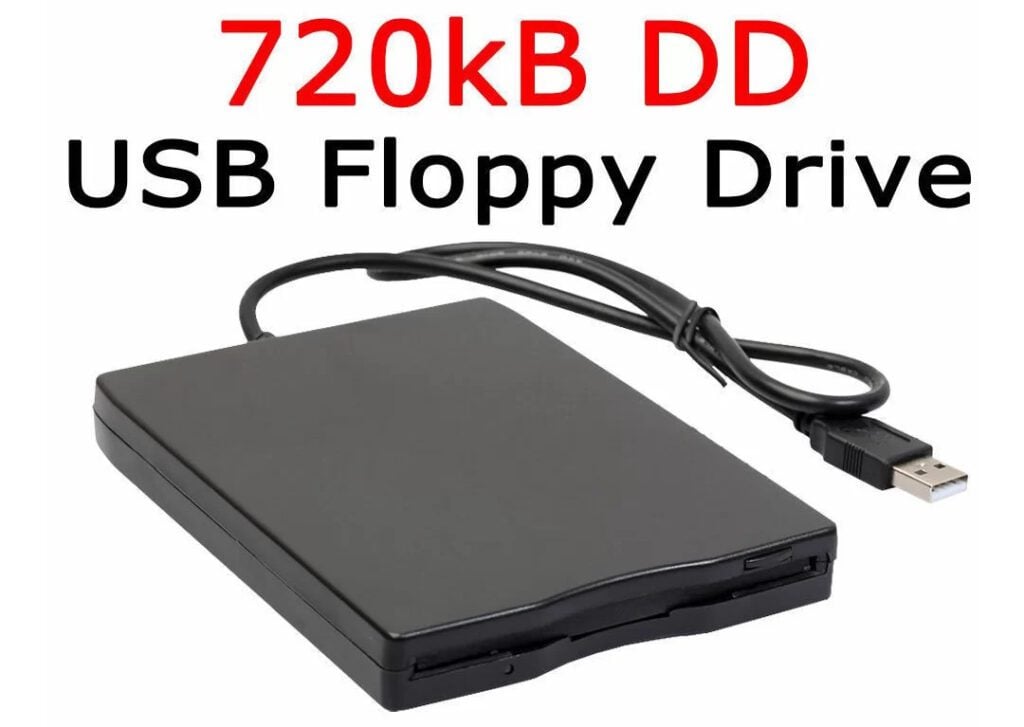So you’ve decided to back up your Yamaha Disklavier floppy disks. And now you need a floppy disk drive that can read them! So what’s the best USB floppy disk drive for our purpose, and especially for reading those earlier, pesky 720 KB double-density (DD) variants used by early Disklaviers? This article explores various options, including generic external floppy drives available on Amazon, Nalbantov’s floppy disk drive offering, and using the Greaseweazle with internal drives.

Generic External Floppy Drives from Amazon
This is the easiest option, and serves most people’s needs. Various generic external USB floppy drives are available on Amazon, often marketed as compatible with both 1.44 MB and 720 KB disks. These drives are typically affordable and offer plug-and-play functionality. One such drive is the Chuanganzhuo USB Floppy Disk drive available on Amazon for $19.
The owner’s manual for the Chuanganzhuo specifies that it’s compatible with 720 KB disks, and I’ve been able to read them without much trouble. I find it somewhat clumsy to use, and I sometimes have to remove the floppy disks with tweezers, but it’s otherwise functional.
Pros
Affordability: These drives are typically $20 or less.
Availability: Widely available with numerous options to choose from. Most are based on the same internal components, and are simply rebranded by different “manufacturers.” (Sometimes they even just put a sticker over the original name.)
Ease of Use: Easy to connect via USB without the need for additional drivers.
Cons
Variable Quality: Build quality and performance can vary significantly, even between orders of the same model. Some of these drives are so poorly made the floppy disks can be difficult to insert and remove.
720 KB Compatibility Issues: Despite claims, some drives struggle with reading 720 KB disks reliably.
Limited Longevity: Durability may be a concern with some models, especially those with less robust construction. Inexpensive drives may come out of alignment and cease to read disks.

Drives from Floppydisk.com
If you want a USB floppy drive with guaranteed compatibility from a U.S.-based source, Floppydisk.com offers both new and tested used drives. These are name-brand drives—Sony, TEAC, IBM—that have been vetted and confirmed to read both 1.44 MB and 720 KB disks. They’re a bit more expensive than the Amazon generics, but you’re getting a one-year warranty.
Pros
Reliable 720 KB Compatibility: All drives are tested and guaranteed to read double-density disks.
U.S.-Based Support: Fast shipping and returns without dealing with overseas sellers.
One-Year Guarantee: Even the used drives come with a full-year warranty.
Cons
More Expensive: $49.95 for new, $24.95 for used
If you want peace of mind and guaranteed 720 KB support from a source that knows floppy disks, Floppydisk.com is a solid mid-tier choice between the gamble of Amazon and the power of a Greaseweazle.
Nalbantov’s Guaranteed 720 KB Drive
Nalbantov has a USB drive you can purchase directly from them. They guarantee that it will work with 720 KB floppy disks. It’s an expensive option at $85 plus shipping.
Pros
Guaranteed Success: You have Nalbantov’s word that these will successfully read your 720 KB disks. You also have access to their excellent customer service.
Cons
Expensive: This option is considerably more expensive than either the generic USB drives or the Greaseweazle described below. It’s not clear that the drives themselves are dramatically better than the generic drives above. They simply come with a guarantee that they work.
Shipping: Nalbantov drives are shipped from Bulgaria, so expect to pay more for shipping. They arrive relatively quickly, but not as quickly as domestic suppliers.

Greaseweazle USB Floppy Adapter with Internal Drives
The Greaseweazle is an adapter that allows users to connect traditional internal floppy drives to modern computers via USB. This setup provides extensive compatibility with various floppy disk formats, including 720 KB DD disks.
Greaseweazle can image floppy disks into an HFE file. That means you can actually image the disk, and then drop the HFE file directly onto your Nalbantov USB stick without ever having to open the file in PPFBU, and without ever using Nalbantov’s disk browser. See my article on how to use a Greaseweazle to prepare files for your Nalbantov.
With the Greaseweazle, you still can use PPFBU. However, you do not read the floppy disks directly. Instead, you take images of the floppy disks, and then pass those images to PPFBU.
You can purchase a Greaseweazle v4.1 from Tindie. Additionally, you’ll need an internal floppy disk drive, such as the Teac FD-235HF or Sony MPF920. You can also purchase an internal drive from Floppydisk.com. If you have access to them, used floppy disk drives pulled from older 90s vintage equipment often read and write 720 KB exclusively, and may be more appropriate if you plan on writing to numerous disks.
If you’re using Windows, see also the FluxMyFluffyFloppy tool. This is a graphical user interface that makes the Greaseweazle much more easily approachable to the novice.
See also the Greaseweazle project on GitHub.
Pros
Broad Compatibility: Capable of reading and writing a wide range of floppy disk formats, including 720 KB floppy disks. It is completely unaffected by Yamaha’s copy protection.
Analysis: Unlike the options above, it actually allows you to evaluate the condition of a floppy disk, reviewing sectors for damage.
Community Support: Active user community provides assistance and firmware updates.
Cons
Complex Setup: Requires assembly and a basic understanding of floppy drive connections. Even when used, these internal drives are dramatically more reliable than the USB drives mentioned above.
Learning Curve: It’s not quite as simple as popping in a disk and reading it. You’ll have to learn how to use the tool and take images of your disks. You’ll have to learn to use either terminal or command-line instructions, or the proper use of tools such as FluxMyFluffyFloppy.

